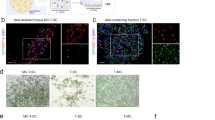Abstract
A β-glucuronidase cDNA was transferred into fetal liver cells (FLC) from mice affected with mucopolysaccharidosis (MPS) type VII and normal littermates using a retrovirus vector. The cells were transduced by direct cocultivation or by culturing the FLC and vector packaging cells separated by a 0.45 μm filter in a dual-chambered cocultivation system. Gene transduction occurred using an ecotropic or amphotropic vector in FLC obtained from 13.5- and 15.5-day-old murine fetuses. Histochemical staining assays and measurement of enzyme activity demonstrated gene expression in the midgestational FLC. Enzyme secreted into the supernatant from transduced FLC obtained from 13.5-day-old affected fetuses surpassed secreted enzyme from normal, age-matched untransduced FLC. The 13.5 day FLC, transduced by direct cocultivation or by using the dual-chambered system, were transplanted in utero into 13.5-day-old murine fetuses. Proviral sequences were detected in various organs shortly after birth. The results indicate that midgestational FLC can be transduced with an amphotropic vector virus in a dual-chambered cocultivation system without contaminating virus-producing packaging cells and that the transduced cells survive in utero transplantation.
Similar content being viewed by others
Author information
Authors and Affiliations
Rights and permissions
About this article
Cite this article
Casal, M., Wolfe, J. Amphotropic and ecotropic retroviral vector viruses transduce midgestational murine fetal liver cells in a dual-chambered cocultivation system. Gene Ther 4, 39–44 (1997). https://doi.org/10.1038/sj.gt.3300352
Received:
Accepted:
Issue Date:
DOI: https://doi.org/10.1038/sj.gt.3300352
- Springer Nature Limited
Keywords
This article is cited by
-
Intrauterine gene transfer: gestational stage-specific gene delivery in mice
Gene Therapy (1999)




